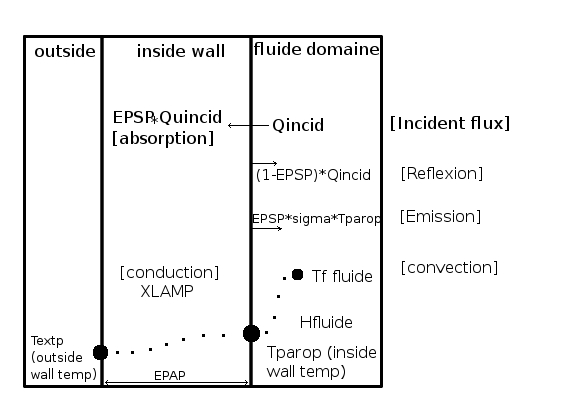The module can be activated in the usppmo routine in cs_user_parameters.f90. The corresponding keyword is iirayo in the cs_glob_rad_transfer_params structure.
This member can take the values:
When the module is activated, its specific input parameters should be set in the cs_user_radiative_transfer_parameters function of the cs_user_radiative_transfer.c file.
Radiative transfer parameters may be defined using the cs_user_radiative_transfer_parameters function.

The radiative boundary condition is based on the calculation of a new wall temperature. This temperature is computed with a thermal flux balance:
![\[{ Q_{conduction} = Q_{convection} + (Q_{rayt_{absorption}} - Q_{rayt_{emission}}}) \]](form_764.png)
Therefore :
![\[ \dfrac{xlamp}{epap} (T_{fluid} - T_{wall}) = h_{fluid} (T_{fluid} - T_{wall}) + epsp (Q_{incid} - \sigma * T_{wall}) \]](form_765.png)
Code_Saturne the flux is positive when it is oriented from inside to outside.| Body | Emissivity |
|---|---|
| polished steel | 0.06 |
| oxidized steel | 0.80 |
| steel rough | 0.94 |
| polished aluminium | 0.04 |
| oxidiezd aluminium (inside) | 0.09 |
| oxidized aluminium (wet air) | 0.90 |
| brick | 0.93 |
| concrete | 0.93 |
| paper | 0.8 to 0.9 |
| water | 0.96 |
Boundary faces may be identified using the getfbr function, or preferrably, through boundary zones, defined using the GUI or the cs_user_zones function..
The following declaration and initialization block needs to be added for the following examples:
Remaining initialisation
ivar: number of the thermal variable
Min and Max values for the wall temperatures (clipping otherwise)
 and
and  are given in Kelvin.
are given in Kelvin.
For each boundary face face_id, a specific output (logging and postprocessing) zone id may be assigned. This allows realizing balance sheets by treating them separately for each zone. By default, the output zone id is set to the general (input) zone id associated to a face.
To access output zone ids (both for reading and modifying), use the cs_boundary_zone_face_zone_id function.
isothp(ifac) boundary face typeCS_BOUNDARY_RAD_WALL_GRAY: Gray wall with temperature based on fluid BCsCS_BOUNDARY_RAD_WALL_GRAY_EXTERIOR_T: Gray wall with fixed exterior temperatureCS_BOUNDARY_RAD_WALL_REFL_EXTERIOR_T: Reflecting wall with fixed outside temperature (same as Gray wall with zero emissivity)CS_BOUNDARY_RAD_WALL_GRAY_COND_FLUX: Gray wall with fixed conduction fluxCS_BOUNDARY_RAD_WALL_GRAY_REFL_FLUX: Reflecting wall with fixed conduction fluxrcodcl = conduction fluxepsp = emissivityxlamp = conductivity (  )
)epap = thickness (  )
)textp = outside temperature (  )
)Here is a list of examples:
For wall boundary faces, selection criteria: color 1
For wall boundary faces, selection criteria: color 2
For wall boundary faces, selection criteria: color 3
For wall boundary faces which have the color 4:
![\[ \begin{array}{rcl} \frac{\texttt{xlamp}}{\texttt{epap}} \cdot (T_{wall} - T_{ext}) &=& \text{fixed conduction flux in } W.m^{-2} \\ &=& \texttt{rodcl(ifac,ivar,3)} \end{array} \]](form_770.png)
If the conduction flux is zero then the wall is adiabatic. The array  has the value of the flux.
has the value of the flux.
Flux density (< 0 if gain for the fluid)
 , in
, in  :
:
![\[ rcodcl(ifac,ivar,3)=C_p (viscls+\frac{visct}{\sigma})\cdot \grad{T}\cdot \vect{n} \]](form_774.png)
 , in
, in  :
:
![\[ RCODC(IFAC,IVAR,3)=(viscls+\frac{visct}{\sigma})\cdot \grad{H} \cdot \vect{n}\]](form_777.png)
For wall boundary faces which have the color 5:
![\[ \frac{xlamp}{epap} \cdot (T_{wall} - T_{ext}) = \text{fixed conduction flux} \]](form_778.png)
and 
If the conduction flux is zero then the wall is adiabatic. Flux density (< 0 if gain for the fluid)
 , in
, in  :
:
![\[ rcodcl(ifac,ivar,3) = C_p (viscls+\frac{visct}{\sigma}) \cdot \grad{T}\cdot \vect{n} \]](form_780.png)
 , in
, in  :
:
![\[ rcodcl(ifac,ivar,3) = (viscls+\frac{visct}{\sigma}) \cdot \grad{H} \cdot \vect{n} \]](form_781.png)
The absorption coefficient and the net radiation flux for the radiative module can be defined in cs_user_radiative_transfer.c through the cs_user_rad_transfer_absorption and Net radiation flux subroutines.
The absorption coefficient is defined in cs_user_rad_transfer_absorption.
The net radiation flux is computed in Net radiation flux.
At the end of the subroutine, if iok is different from zero, some faces have been forgotten and the calculation stops.